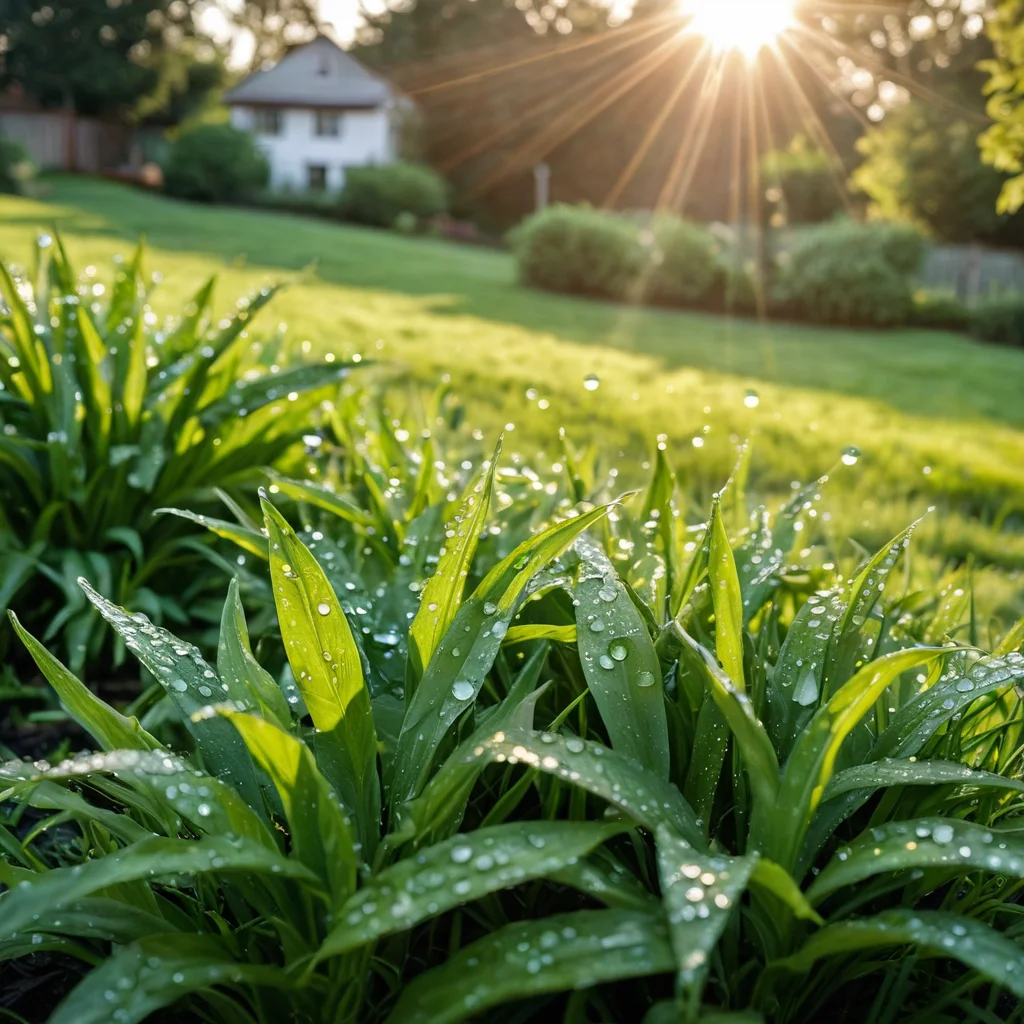The smell of freshly cut grass, the feeling of a velvety carpet underfoot, perfect greenery framing flower beds and garden paths… A lawn is the heart of any well-kept plot, a true work of art created by nature and your own hands. But what if I told you that this beauty can be preserved and enhanced by giving up aggressive chemicals? That your lawn can be not only impeccable but also beneficial for the environment, for pets, and for yourselves? This is not a utopia, but a perfectly achievable task for anyone willing to listen to nature and put in a little effort. Let me share my experience and secrets on how to turn lawn care into a real pleasure, and the result – a reason to be proud.
Why a Chemical-Free Lawn: Health, Ecology, and Beauty for Your Plot
Have you ever wondered what lies behind that perfect green picture created with chemical fertilizers and herbicides? Of course, the result can be impressive, but at what cost? I always try to approach gardening with care for health – my own, my family’s, pets’, and, of course, the planet’s. The use of chemicals is a direct path to polluting soil, water, and air. Think about how these substances can get into groundwater, harm beneficial insects (yes, even bees!), spoil the taste of berries growing nearby, or cause allergies in your children and pets.
Giving up chemicals is not just a trendy fad; it’s a conscious choice in favor of:
- Health: You create a safe space for children and pets to play, free from the risk of contact with toxic substances.
- Ecology: You support the biodiversity of your plot, preserving soil microflora, attracting beneficial insects and birds. You do not pollute the environment.
- Durability: Healthy soil, enriched with organic matter, is itself the best foundation for a strong and resilient lawn. Such a lawn is less susceptible to diseases and recovers more easily.
- Economy: Many natural lawn care products are affordable and even free if you approach the matter creatively.
- Pleasure: Lawn care becomes a more natural process, closer to nature, rather than a struggle against it.
Believe me, a beautiful and healthy lawn is not a myth, but the result of a correct, caring, and, most importantly, ecological approach. Today, there are many proven ways to keep it in perfect condition using only natural resources.
Types of Eco-Friendly Lawn Fertilizers: From Compost to Green Manures
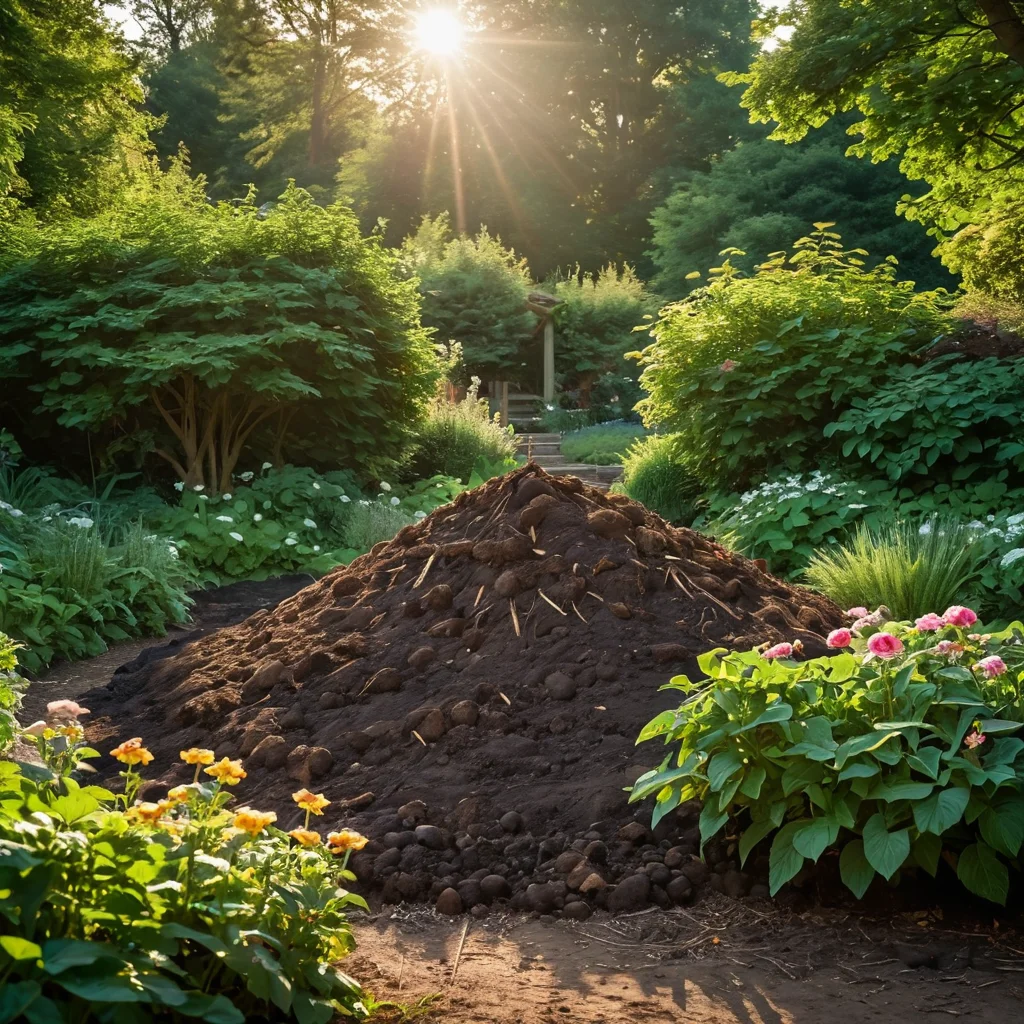
Fertilization is perhaps the most important aspect of caring for any plant, and the lawn is no exception. But why buy expensive chemical compounds when nature itself offers us a whole arsenal of nutrients? I have experimented a lot and concluded that organic farming yields the best results. It not only nourishes the grass but also improves soil structure, making it looser, more moisture-retentive, and alive.
Compost – Gold for Your Lawn
Compost is a true storehouse of nutrients. You can prepare it yourself from plant residues, kitchen waste (without meat and dairy products), and fallen leaves. The composting process takes time, but the result is worth it. Properly prepared compost is a crumbly, dark mass with a pleasant earthy smell, rich in all necessary macro- and microelements.
How to Use Compost for Your Lawn:
- Spring Application: The best time is early spring when the grass is just starting to wake up. Evenly spread a thin layer (1-2 cm) of mature compost over the entire lawn surface. This will provide the grass with nutrients for the entire growing season.
- Feeding: Light feeding with compost tea can be done during the season. To prepare it, soak a bucket of compost in a large water tank for several days, stirring occasionally. Dilute the resulting infusion with water (approximately 1:10) and water the lawn.
Manure – Concentrated Nutrition
Manure, especially well-rotted manure (cow, horse), is a more concentrated fertilizer than compost. It can also be used, but with greater caution. It is important that the manure is fully rotted, otherwise, it can “burn” the grass roots. It is ideal to use manure that is 2-3 years old.
How to Use Manure:
- Mixing with Soil: When establishing a new lawn, manure can be incorporated into the soil during digging.
- Mulching (with caution!): A very thin layer of manure can be used for mulching, but only if you are confident in its quality and degree of decomposition.
Green Fertilizers – Green Manures
Green manures are plants sown not for harvest but for subsequent incorporation into the soil to improve and enrich it. They perfectly loosen the soil, enrich it with nitrogen (especially legumes), suppress weed growth, and serve as food for soil microorganisms.
Popular Green Manures for Lawns:
- Mustard: Grows quickly, enriches the soil, repels some pests.
- Rye: Loosens heavy soils well, suppresses weeds.
- Phacelia: Unpretentious, grows well on any soil, attracts beneficial insects.
- Clover: Enriches the soil with nitrogen, makes the lawn denser and more resistant to trampling, and is itself a good ground cover plant.
How to Use Green Manures:
- Pre-sowing Preparation: Sow green manures 3-4 weeks before the main grass planting or before autumn sowing.
- Incorporation into Soil: When the green manures reach a height of 15-20 cm, they should be mowed and incorporated into the topsoil. Let them decompose (2-3 weeks) before sowing grass.
- As Overseeding: Low-growing clover varieties can be overseeded onto an existing lawn to thicken and enrich it.
Other Organic Fertilizers
- Wood Ash: A source of potassium and phosphorus, as well as trace elements. Use in moderation, as ash can increase soil alkalinity. It is best suited for acidic soils. Apply in autumn or spring.
- Bone Meal: A slow-release source of phosphorus and calcium. Good for young lawns.
- Horn Meal: An excellent slow-release source of nitrogen.
Remember that the main rule when using organic fertilizers is moderation. It’s better to underfeed than overfeed. And always pay attention to the condition of the soil and grass, adjusting feeding as needed.
Weed Control Without Herbicides: Proven Folk and Mechanical Methods
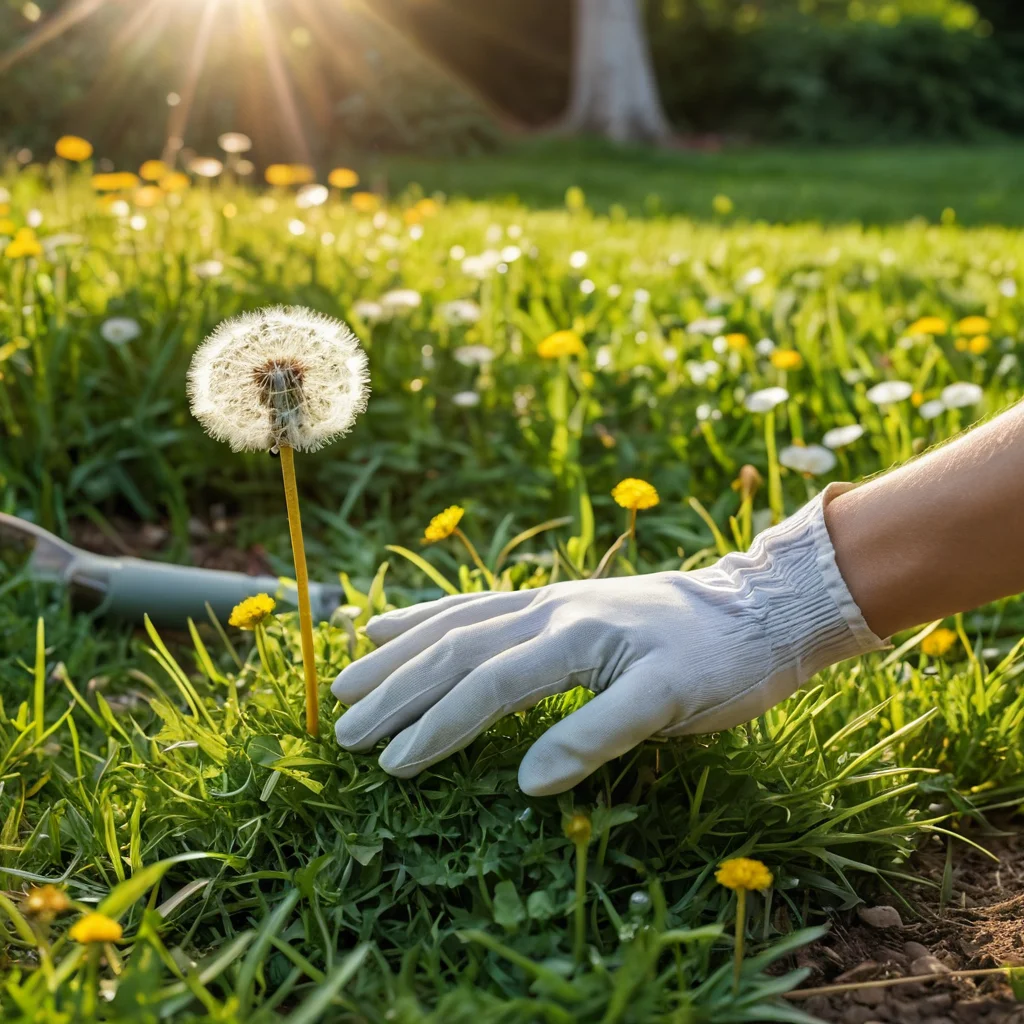
Oh, weeds! This is perhaps the biggest headache for any gardener, especially when it comes to lawns. They not only spoil the appearance but also take moisture, light, and nutrients away from the lawn grass. But don’t rush to grab chemical “killers.” There are ways to deal with them without resorting to harmful chemicals. The key is regularity and a comprehensive approach.
Mechanical Control – The Foundation
The simplest and most effective way to combat weeds is physical removal. Yes, it takes time and effort, but the result is worth it.
- Hand Weeding: This is the ideal option for dealing with individual weeds or small patches. It’s best to weed when the soil is moist – after rain or watering. Be sure to pull the weed out by the root, otherwise, it will quickly regrow. Pay special attention to tap-rooted weeds (couch grass, thistles) where even a small piece of root can give rise to a new plant.
- Using Tools: There are special tools for removing weeds with long roots (e.g., root pullers). If you have a large area, you can use a hoe or cultivator to remove annual weeds before mowing.
Creating Unfavorable Conditions for Weeds
A healthy, dense lawn is the best defense against weeds. Weeds love bare spots and weakened grass. Therefore, our task is to make it simply impossible for them to grow.
- Proper Mowing: Don’t mow the lawn too short! The optimal height is 4-5 cm. Tall grass competes better with weeds, shading them and preventing their growth. Mow the grass regularly, but no more than a third of its height at a time.
- Dense Sowing: When creating a new lawn, use high-quality seeds and adhere to recommended sowing rates. The denser the grass seedlings emerge, the fewer chances weeds will have.
- Aeration and Scarification: These procedures help improve soil structure, remove old grass and moss, and stimulate lawn grass growth, making the lawn more resistant to weeds.
Folk Remedies – Time-Tested
There are many “grandmother’s” recipes that can help combat unwanted vegetation.
- Vinegar: A weak solution of vinegar (9%) can be used for spot spraying weeds, especially on paths or between paving stones. It acts as a contact herbicide, burning the leaves. Use with caution to avoid damaging the lawn grass. It’s best applied on a hot sunny day.
- Salt: A strong salt solution can also be effective against weeds, but it should be used with extreme caution. Salt remains in the soil for a long time and can harm lawn grass. It’s best used on paths or in areas where no lawn is planned.
- Boiling Water: Simple boiling water is an excellent way to get rid of weeds on paths or in cracks. Just pour boiling water over the weed. It’s eco-friendly and effective.
- Mulching: As I mentioned earlier, mulching is an excellent way to suppress weed growth by depriving them of light.
Prevention – The Best Strategy
The most effective way to combat weeds is to prevent their appearance. How to do this?
- Use Quality Seeds: Make sure your seed mix does not contain weed seeds.
- Improve the Soil: Healthy, fertile soil promotes the growth of strong lawn grass, which will naturally outcompete weeds.
- Regularly Inspect the Lawn: The sooner you spot a weed, the easier it will be to remove.
Remember that a perfect lawn without a single weed is more of a dream than a reality. But maintaining it in excellent condition, timely removing unwanted “guests,” is quite achievable using natural methods.
Strengthening Your Lawn Naturally: Proper Watering and Aeration
A strong, healthy lawn is not just about proper feeding and the absence of weeds. It’s also about competent care for the soil and the grass’s root system. Two crucial processes that are often underestimated are watering and aeration. They help the grass feel comfortable, receive enough air and moisture, and stimulate the growth of strong, deep roots.
The Art of Proper Watering
Watering a lawn is not just about “quenching” the grass. It’s a whole science, especially if you want to avoid chemicals and achieve a truly healthy turf.
- Depth is Everything: The main rule is to water abundantly but less frequently. Instead of daily “showers” that only moisten the topsoil and encourage shallow root growth, it’s better to give the lawn a “deep soak.” Water so that it penetrates to a depth of 10-15 cm. This encourages roots to grow downwards in search of moisture, making the lawn more drought-resistant.
- When to Water? The best time for watering is early morning (before 10 am) or late evening (after 6 pm). At these times, evaporation is minimal, and the water has time to be absorbed. Watering during the day in hot weather can cause leaf scorch (lens effect).
- Determining the Need: How to tell if the lawn needs watering? A simple test: walk on the grass. If you leave flattened footprints on the leaves that don’t spring back within half an hour, it’s time to water.
- Use Rainwater: If possible, collect rainwater. It’s soft, free of chlorine and other impurities found in tap water. It’s a real gift for your lawn.
- Consider the Weather: In hot, dry weather, watering will be needed more often; in cool, rainy weather – less often. Don’t forget that a lawn is a living organism, and it will tell you when it needs help.
Aeration: Letting the Lawn Breathe
Over time, especially in areas with heavy use, the soil under the lawn becomes compacted. Grass roots begin to suffer from a lack of air and water, and a felt layer of dead grass and moss forms, hindering the penetration of nutrients.
What is Aeration? It’s the process of piercing the lawn’s turf to allow air, water, and nutrients to reach the root system. It’s like “breathing” for your lawn.
When and How to Aerate?
- Frequency: The best time for aeration is spring and autumn, when the lawn is actively growing. It’s sufficient to perform the procedure 1-2 times a year.
- Aeration Methods:
- Manual Aerator: This is a special tool with hollow tines that extracts small soil plugs from the ground. Very effective, but requires physical effort.
- Garden Fork: You can use a regular garden fork, piercing the soil to a depth of 10-15 cm. If the soil is very dense, the fork may get stuck.
- Special Aerators: Various mechanical and electric aerators are available for purchase, which will significantly ease the work.
- Foot Aerators: Convenient sandals with spikes that are worn over shoes. Ideal for small areas.
- What to Do After Aeration: After aeration, the loosened lawn surface is ideal for applying fertilizers (especially compost) and overseeding. If you used a hollow-tine aerator, you will get soil “plugs” that should either be scattered over the lawn or collected for other purposes.
Scarification – Removing Thatch
Scarification (raking) is a procedure closely related to aeration. It aims to remove the thatch layer, moss, and dry grass that prevent the lawn from breathing and developing. Scarification is best done in spring, after the first mowing, or in autumn.
- Tools: Use special scarifying rakes or mechanical scarifiers.
- Technique: Perform the procedure on dry grass, moving in different directions. Do not overdo it, so as not to damage the healthy grass.
- After Scarification: The collected thatch can be sent to the compost. After the procedure, it’s advisable to fertilize the lawn and, if necessary, overseed bare patches.
Proper watering and aeration are the keys to the health and longevity of your lawn. These simple yet crucial procedures will help the grass form a deep root system, become more resistant to drought, diseases, and trampling, and allow you to enjoy its beauty without unnecessary chemicals.
Lawn Mulching: Benefits and How to Do It Correctly
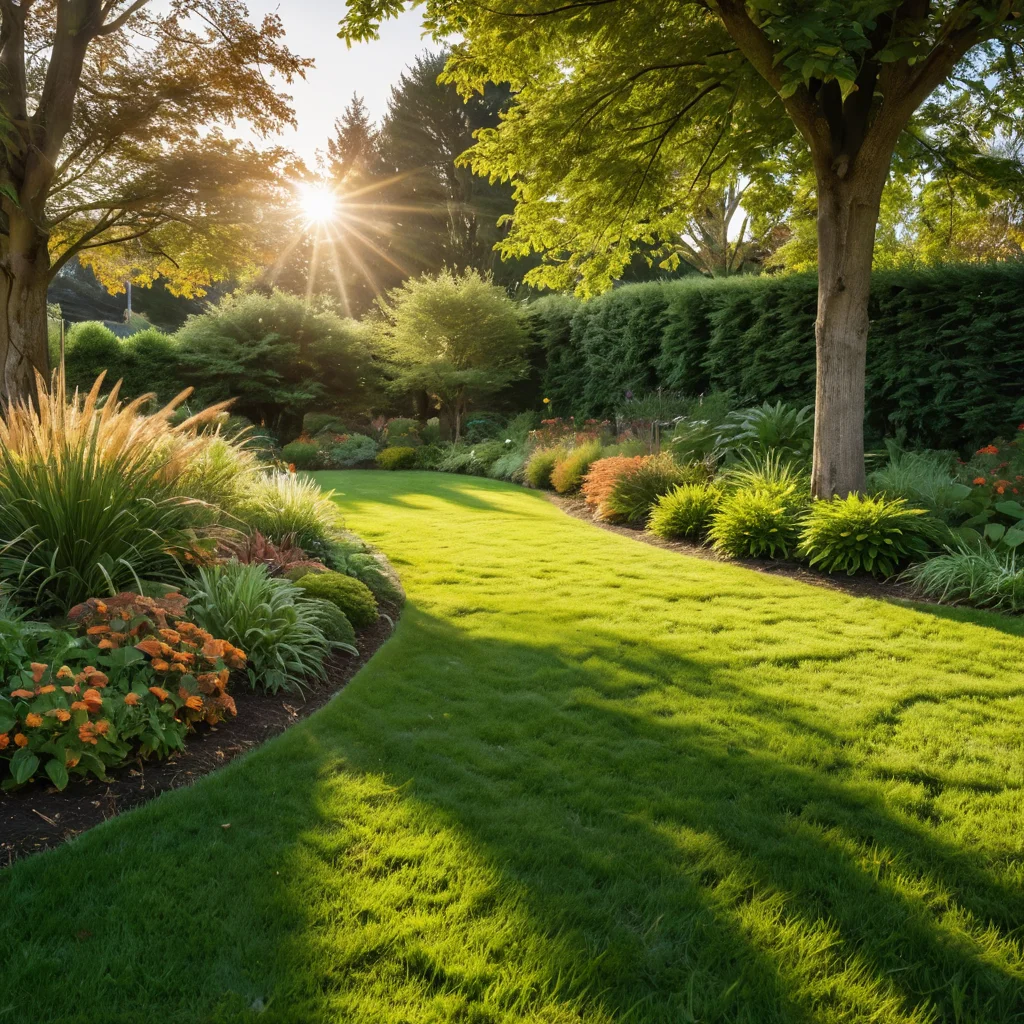
When I first started my gardening journey, I didn’t think much about mulching. It seemed more suitable for flower beds and vegetable patches. But experience has taught me that mulch is a true friend to the lawn too! Especially if we’re talking about an eco-friendly approach. Mulching helps retain moisture, suppress weed growth, improve soil structure, and even enrich it with beneficial substances. Today, I want to share with you the secrets of how to properly mulch your lawn so that it delights you with its greenery and health.
Why Mulch Your Lawn?
First of all, let’s understand what benefits mulch brings to lawn grass:
- Moisture Retention: Mulch creates a protective layer on the soil surface that reduces moisture evaporation. This is especially important during hot, dry summers when the lawn needs constant hydration.
- Weed Control: A dense layer of mulch blocks sunlight, which is necessary for weed seeds to germinate. This significantly reduces their numbers and helps the lawn stay clean.
- Maintaining Optimal Temperature: Mulch protects the soil from overheating on hot days and from sharp temperature fluctuations. This creates a more comfortable environment for the grass’s root system.
- Improving Soil Structure: Organic mulch decomposes over time, enriching the soil with humus. This makes the soil looser, more permeable to air and water.
- Erosion Protection: Mulch helps retain the topsoil, preventing it from being washed or blown away during heavy rains or wind.
What Materials to Use for Lawn Mulching?
The choice of mulch depends on your preferences and the availability of materials. It’s important that the mulch is environmentally friendly and does not contain weed seeds.
- Grass Clippings: The most accessible and simplest option. After mowing with a mulching lawnmower, the remaining grass itself becomes excellent mulch. It’s important that the grass clippings are not too long and have time to dry, otherwise, they can clump and cause rot.
- Compost: Mature, well-rotted compost is an ideal option. It not only mulches but also nourishes the soil.
- Shredded Bark or Wood Chips: This type of mulch is more decorative and durable. It looks good on garden paths, but is used less often for lawns. It’s important that the bark is well-rotted and does not contain aggressive essential oils.
- Sawdust: Can be used, but with caution. Fresh sawdust can acidify the soil and “draw out” nitrogen. It’s better to use rotted sawdust or mix it with nitrogen fertilizers.
- Leaves: Fallen autumn leaves are an excellent mulching material. They can be shredded with a garden vacuum or lawnmower before laying.
Lawn Mulching Technique
Mulching a lawn is not a difficult procedure, but there are a few important nuances:
- Layer Thickness: Do not lay the mulch too thickly. The optimal thickness is 2-3 cm. Too thick a layer can lead to root rot and restrict air access.
- Distribution: Mulch should be evenly distributed over the entire lawn surface, trying not to cover the base of the grass blades.
- Timing: Lawn mulching can be done at any time during the growing season. In spring – to maintain moisture and control weeds. In summer – to protect from overheating and drought. In autumn – to protect roots from frost and enrich the soil.
- Mulching with Grass Clippings: If you use the mulching function on your lawnmower, make sure the grass is not too long and has time to dry. If the grass is wet and dense, it’s better to collect it and use it for compost or as separate mulch.
Mulching is another step towards creating a truly healthy and beautiful lawn without chemicals. It’s a simple, accessible, and very effective way to improve soil condition and care for your green lawn.
Seasonal Lawn Care: Spring, Summer, Autumn Without Chemicals
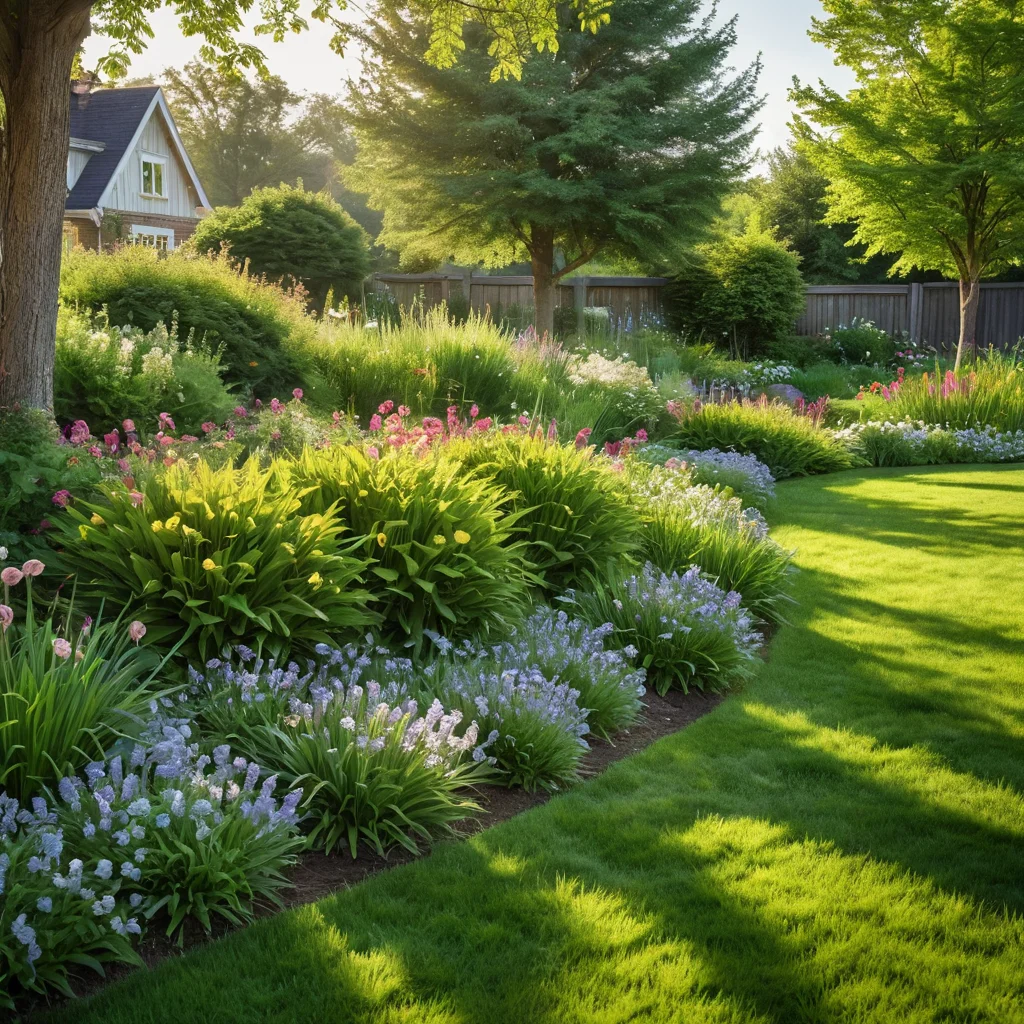
Each season has its own demands for lawn care. And if you’ve decided to give up chemicals, it’s important to know how to adapt your procedures to seasonal changes. I love observing my lawn, listening to its needs. This allows me to take the necessary measures in time and keep it healthy and beautiful year-round.
Spring: Awakening and Restoration
Spring is the time when our lawn wakes up from its winter slumber. The primary task is to help it recover and gain strength.
- First Mowing: As soon as the grass grows to 7-8 cm, perform the first mowing. Don’t cut too much; leave a height of about 5-6 cm. Start mowing when the grass is dry.
- Scarification: After winter, a thatch layer of old grass and moss often forms on the lawn. Be sure to scarify (rake) with scarifying rakes to remove this layer and give the grass access to light and air.
- Aeration: If the soil has become heavily compacted over winter, aerate by piercing the turf with a fork or a special tool.
- Fertilizing: In spring, the lawn needs nutrients. The best organic fertilizer is well-matured compost. Spread a layer (1-1.5 cm) evenly over the entire surface. Compost tea can also be used.
- Dealing with Bare Patches: After winter, bare spots may appear. Thoroughly loosen them, add compost, and overseed with a lawn mix.
- Weed Control: Start monitoring for weeds and remove them manually in a timely manner.
Summer: Maintaining Beauty and Protection from Heat
Summer is the peak season for lawn activity, but also a time of trials – heat, drought, increased use.
- Regular Watering: Follow the rule of abundant but infrequent watering. Water early in the morning or late in the evening to avoid burns and maximize moisture retention.
- Proper Mowing: Continue to mow the lawn regularly, maintaining a height of 4-5 cm. Do not cut more than a third of the height at once. If the grass has grown too long, it’s better to do it in several stages.
- Mulching: If you use the mulching function on your lawnmower, monitor the grass condition. If necessary, it’s better to collect the clippings to avoid rot.
- Weeding: Continue to remove weeds regularly, preventing them from spreading and going to seed.
- Disease Control: Signs of disease (spots, discoloration) can appear in hot and humid weather. Ensure the lawn is well-drained, avoid overwatering. For treatment, you can use biological preparations based on Bacillus subtilis or other natural remedies.
Autumn: Preparing for Winter
Autumn is the time when the lawn prepares for its dormant period. Our task is to help it survive the winter and lay the foundation for a successful awakening in spring.
- Last Mowing: Perform the last mowing in late October – early November, leaving the grass height at about 5-6 cm. This will help prevent rotting under the snow.
- Leaf Removal: Regularly remove fallen leaves from the lawn. They can mat down, preventing air circulation and promoting the development of fungal diseases. Leaves can be used for compost or mulch.
- Fertilizing: Autumn fertilization is important for strengthening the root system. Use organic fertilizers rich in potassium and phosphorus (e.g., wood ash, bone meal). It’s best to exclude nitrogen fertilizers in autumn.
- Aeration and Scarification: If necessary, perform these procedures to improve drainage and remove thatch remnants.
- Checking for Bare Patches: Assess the lawn’s condition and, if necessary, overseed bare areas.
- Fungal Disease Prevention: Ensure good drainage, avoid waterlogging.
Seasonal lawn care without chemicals is not difficult if you understand the grass’s needs during different times of the year. The key is regularity, attention, and care, and your lawn will repay you with lush greenery and a healthy appearance.
Common Mistakes in Chemical-Free Lawn Care and How to Avoid Them
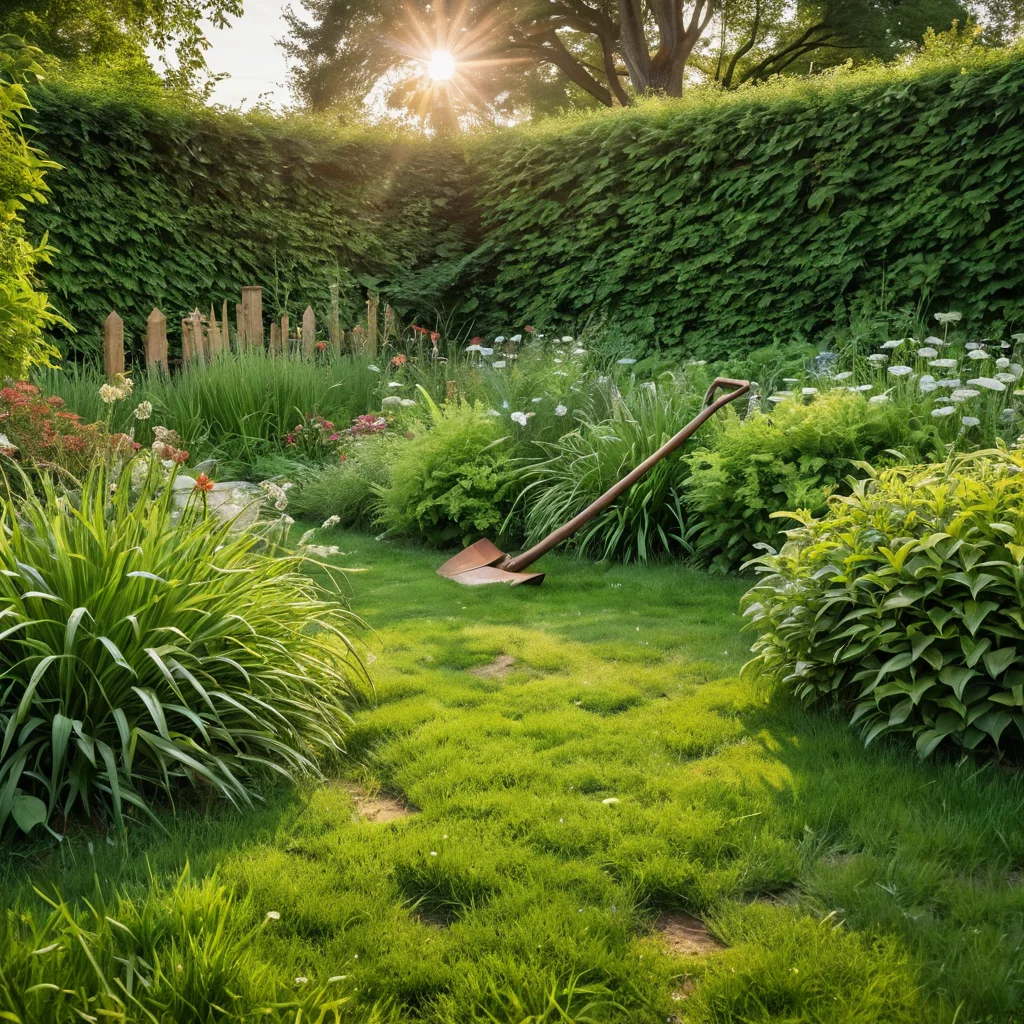
Even when following all the rules, mistakes can sometimes be made that negatively affect the lawn’s condition. This is especially true when transitioning to organic care, when we don’t fully understand all the nuances. I’ve been through it myself, so I want to share the most common mistakes and tell you how to avoid them so that your lawn always looks its best.
- Mistake #1: Mowing Too Short.
Why it’s bad: Short-mown grass weakens, its roots become shallow. Such a lawn becomes vulnerable to drought, diseases, and weeds. Moreover, frequent and short mowing can lead to bare patches.
How to avoid: Always follow the rule – cut no more than a third of the grass’s height at a time. The optimal lawn height is 4-5 cm. During hot weather, you can leave the grass slightly longer. - Mistake #2: Over- or Under-watering.
Why it’s bad: Daily “showers” lead to shallow root development, making the lawn dependent on moisture. Watering too infrequently in hot weather causes the grass to dry out and die. Lack of moisture weakens the grass, making it vulnerable.
How to avoid: Water the lawn abundantly but infrequently, so that water penetrates deep into the soil (10-15 cm). Rely on the grass’s condition and weather conditions. Water early in the morning or late in the evening. - Mistake #3: Neglecting Aeration and Scarification.
Why it’s bad: Soil compaction and thatch formation prevent air, water, and nutrients from reaching the roots. This slows down grass growth, promotes the development of moss and diseases.
How to avoid: Regularly (1-2 times a year, in spring and autumn) perform aeration and scarification, especially in high-traffic areas. - Mistake #4: Delayed Weed Removal.
Why it’s bad: Weeds grow rapidly, smother lawn grass, and take away its moisture and nutrients. If you let them go to seed, combating them becomes much more difficult.
How to avoid: Weed the lawn regularly, especially young weeds, pulling them out by the root. Use preventive measures: dense sowing, proper mowing. - Mistake #5: Using Unripe Compost or Manure.
Why it’s bad: Unrotted manure can “burn” grass roots due to high ammonia concentration. Unripe compost may contain weed seeds and pathogenic microorganisms.
How to avoid: Use only fully mature, well-rotted compost or manure (at least 2-3 years old). - Mistake #6: Neglecting Seasonal Care.
Why it’s bad: Each season requires its own procedures. Neglecting spring scarification, summer watering, or autumn preparation for winter weakens the lawn and reduces its resilience.
How to avoid: Strictly follow the seasonal care plan, considering the specifics of each time of year. - Mistake #7: Mulching Too Thickly.
Why it’s bad: A thick layer of mulch (especially from grass clippings) can lead to root rot, restrict air access, and provoke fungal development.
How to avoid: Apply mulch in a thin layer (2-3 cm), distributing it evenly over the surface.
A conscious approach and attention to detail will help you avoid these common mistakes. Remember that chemical-free lawn care is a process that requires patience and regularity, but the result – a healthy, beautiful, and eco-friendly turf – is worth all the effort!
Creating the Perfect Lawn Without Chemicals: A Checklist for Beginners
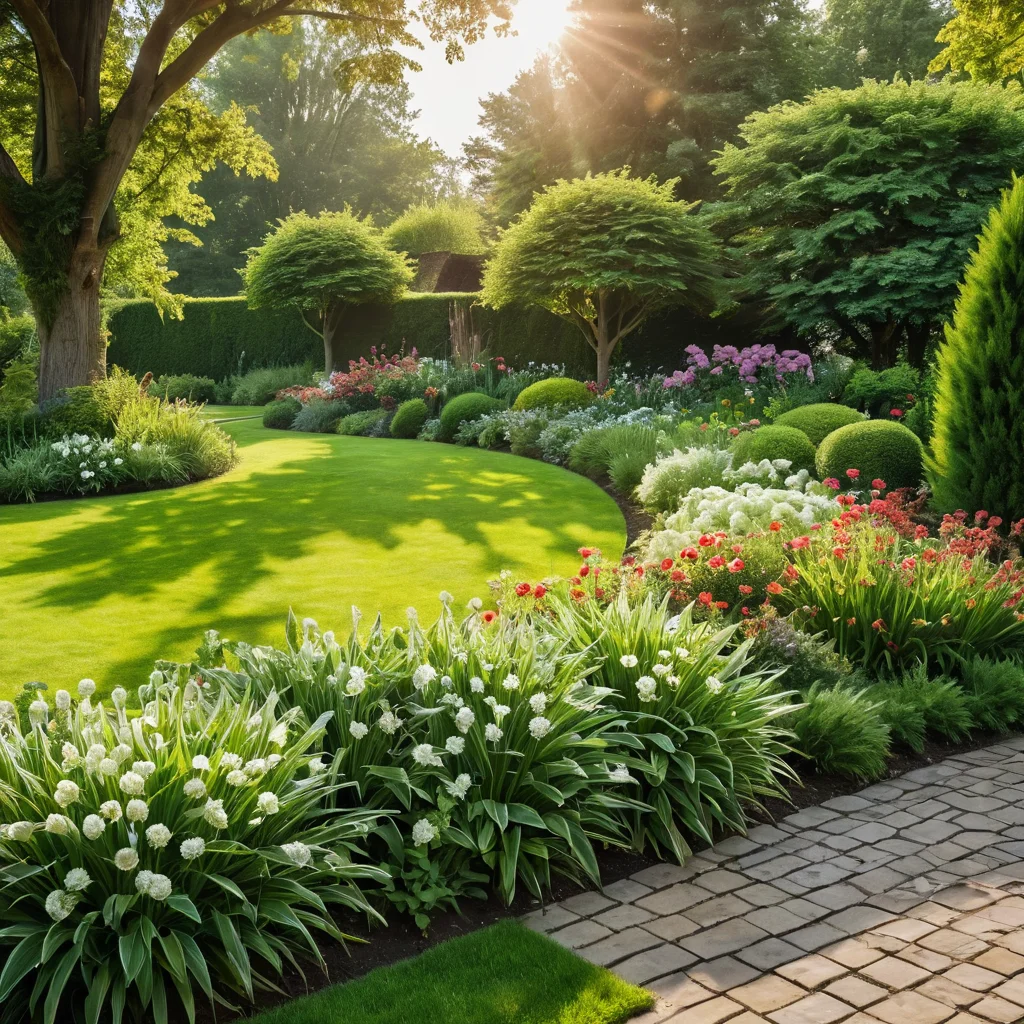
So, you’ve decided to create or maintain your lawn in perfect condition by giving up chemicals. That’s a wonderful decision! To make it easier for you, I’ve prepared a small checklist. Go through it before starting your work, and then use it as a reminder throughout the season.
Preparation and Planting (for a New Lawn)
- [ ] Choosing a suitable location: sunny, level, with good drainage.
- [ ] Soil preparation: deep digging (20-25 cm), removal of stones and roots of perennial weeds.
- [ ] Soil enrichment: application of mature compost (5-10 kg per sq.m.) or manure.
- [ ] Leveling: thorough leveling of the surface with a rake.
- [ ] Seed selection: purchasing a high-quality lawn mix suitable for your conditions (sun/shade, traffic).
- [ ] Sowing: adhering to recommended sowing rates (usually 30-50 g per sq.m.), even distribution of seeds.
- [ ] Covering seeds: lightly covering with soil or rolling with a lawn roller.
- [ ] First watering: abundant but gentle, to avoid washing away seeds.
Seasonal Care
- Watering:
- [ ] Abundant but infrequent watering (1-2 times a week, depending on the weather).
- [ ] Watering early in the morning or late in the evening.
- [ ] Monitoring soil moisture depth (10-15 cm).
- Mowing:
- [ ] Regular mowing (as it grows).
- [ ] Maintaining a height of 4-5 cm.
- [ ] Cutting no more than 1/3 of the height at a time.
- [ ] Using sharp mower blades.
- Fertilizing:
- [ ] Spring fertilization with compost or compost tea.
- [ ] Summer feeding (if necessary) – light, organic.
- [ ] Autumn feeding (potassium, phosphorus – ash, bone meal).
- Weed Control:
- [ ] Regular hand weeding (by the root!).
- [ ] Prevention (dense lawn, proper mowing).
- Aeration and Scarification:
- [ ] Spring scarification and aeration.
- [ ] Autumn aeration (if needed).
- Mulching:
- [ ] Mulching with grass clippings (if using the mulching function) or a thin layer of compost.
Seasonal Tasks
- Spring: Scarification, aeration, first mowing, main spring fertilization, dealing with bare patches.
- Summer: Regular watering, mowing, weeding, monitoring the lawn’s condition.
- Autumn: Leaf removal, last mowing, autumn fertilization, final aeration (if needed), preparation for winter.
This checklist is your reliable assistant on the path to creating a beautiful lawn without chemicals. The key is to act consistently and with love for your plot. Good luck with your gardening endeavors!
